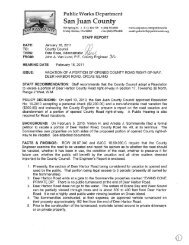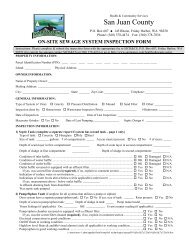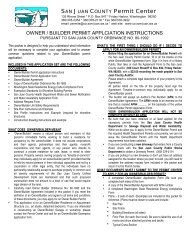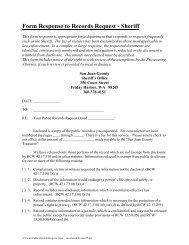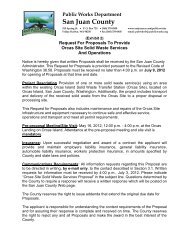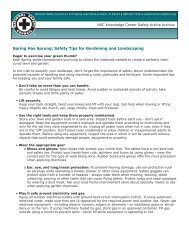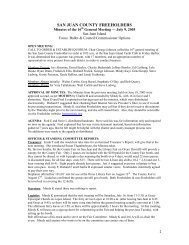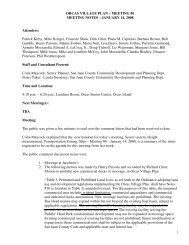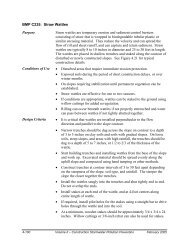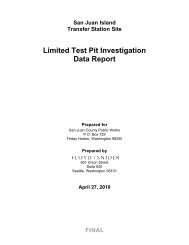Ordinance No._____- 2012 AN ORDINANCE ... - San Juan County
Ordinance No._____- 2012 AN ORDINANCE ... - San Juan County
Ordinance No._____- 2012 AN ORDINANCE ... - San Juan County
You also want an ePaper? Increase the reach of your titles
YUMPU automatically turns print PDFs into web optimized ePapers that Google loves.
Orcas and Blakely Islands. They are not<br />
currently known to nest in the <strong>San</strong><br />
<strong>Juan</strong>s, but that could change as second<br />
growth forests mature.<br />
Page 49 of 56<br />
Ord. ____-<strong>2012</strong><br />
of Fish and Wildlife to develop a site specific<br />
protection plan.<br />
Merlin Edges of conifer woodlands. ●Prevent disturbance of active nesting areas<br />
during the spring.<br />
<strong>No</strong>rthern<br />
goshawk<br />
Mature forest on main islands.<br />
●Prevent disturbance of active nesting areas<br />
during the spring.<br />
<strong>No</strong>rthern harrier<br />
<strong>No</strong>rthern pygmyowl<br />
Infrequently mowed pastures, prairie,<br />
and herbaceous wetlands without trees.<br />
Mature conifer forest on main islands.<br />
●Prevent disturbance of active nesting areas<br />
during the spring.<br />
●In areas with northern harriers, establish<br />
wetland buffers based on a Water Quality-<br />
Sensitivity Rating of “High” and a Habitat<br />
Importance-Sensitivity Rating of “High”.<br />
Protect buffers in accordance with SJCC<br />
18.30.150.<br />
Protect larger herbaceous wetlands.<br />
●Prevent disturbance of active nesting areas<br />
during the spring.<br />
Peregrine falcon Year-round resident in SJ <strong>County</strong> (≈ 21<br />
nesting pairs). Nests on cliffs and<br />
ledges. Feed on birds, especially<br />
shorebirds and waterfowl.<br />
●Within ¼ ½ mile of nests, avoid construction<br />
and activities that may disturb nesting birds<br />
March 1 – June 30.<br />
●If possible locate structures at least 1,500 feet<br />
back from cliffs with nests (recommendation).<br />
●Within 250 ft. of the shoreline for ½ mile on<br />
either side of the nest, maintain 50 % of all<br />
trees, with a mix of size classes, and all trees<br />
≥24 in. dbh .<br />
●Prevent pesticide and chemical contamination<br />
of prey. and food sources includChemicals of<br />
particular concern include: ing lead, mercury,<br />
organochlorides, organophosphates, carbofuran,<br />
and famphur (recommendation).<br />
▪Near nesting and feeding areas, dDo not use<br />
lead shot, and avoid use of insecticide, and<br />
avoid use of pesticides that will be injested by<br />
birds that are food sources (e.g.<br />
pigeons).including rodenticides and<br />
insecticides near nesting & feeding areas.<br />
▪Avoid use of treated wood products.<br />
▪Follow <strong>County</strong> stormwater and buffer<br />
requirements.<br />
●Avoid construction of power lines near nests or<br />
feeding areas (recommendation).<br />
●Maintain trees along shorelines in<br />
conformance with this section.<br />
Comment [S10]: Revised to be consistent with<br />
more recent guidance.<br />
N:\L<strong>AN</strong>D USE\LONG R<strong>AN</strong>GE PROJECTS\PCODES-11-0004 CAO FWHCAs\Docs from PC and CC\FWHCAOrdCC_<strong>2012</strong>-10-26.doc



